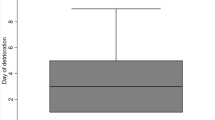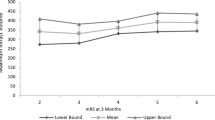Summary
Massive hemispheric cerebral infarction, also known as malignant infarction, is characterized by rapid clinical deterioration due to brain swelling and downward transtentorial herniation, and is associated with a mortality of 80%. Early patient selection and establishment of the optimum therapeutic modality are important to improve the outcome. Early clinical, computed tomography (CT), and angiographic characteristics were analysed to identify patients with malignant infarction and external and internal decompression was performed, with unco-parahippocampectomy if needed, and the outcomes were compared with those of conservative treatment.
Thirty-four of 55 patients admitted with large cerebral infarctions due to embolism showed rapid clinical deterioration due to brain swelling and herniation. These 34 patients were treated under a diagnosis of malignant infarction by decompressive surgical treatment (19 cases) or conservative treatment (15 cases).
CT showed significantly higher infarction volume in patients with malignant infarction (288±62 cm3) compared to patients with non-malignant infarction (200±57 cm3, P<0.001) and angiography showed a higher incidence of recanalization of the occluded vessels in patients with malignant infarction (58%) compared to patients with non-malignant infarction (15%, P<0.05). Discriminant analysis revealed that an infarction volume of more than 240 cm3 was predictive of malignant infarction with 76.4% accuracy. Basic clinical characteristics on admission and deterioration were not statistically different between the surgically treated and conservatively treated groups of patients with malignant infarction. The shift of midline structures was significantly improved (14±3.5 to 10±4.7 mm) after surgical treatment (P<0.05), compared to deterioration (12±5.8 to 15±4.5 mm) after conservative treatment. The mortality was 67% in the conservative group and 16% in the surgical group. Surgical treatment significantly improved the mortality and Glasgow Outcome Scale score (P<0.01). However, the mean Barthel Index scores of the survivors were not significantly different.
An infarct volume of more than 240 cm 3 on CT and angiographic recanalization of the occluded artery are predictors of fatal brain swelling after massive cerebral infarction. Decompressive surgical treatment dramatically improves the mortality of massive hemispheric infarction.
Similar content being viewed by others
Author information
Authors and Affiliations
Rights and permissions
About this article
Cite this article
Mori, K., Aoki, A., Yamamoto, T. et al. Aggressive Decompressive Surgery in Patients with Massive Hemispheric Embolic Cerebral Infarction Associated with Severe Brain Swelling. Acta Neurochir (Wien) 143, 483–492 (2001). https://doi.org/10.1007/s007010170078
Issue Date:
DOI: https://doi.org/10.1007/s007010170078




